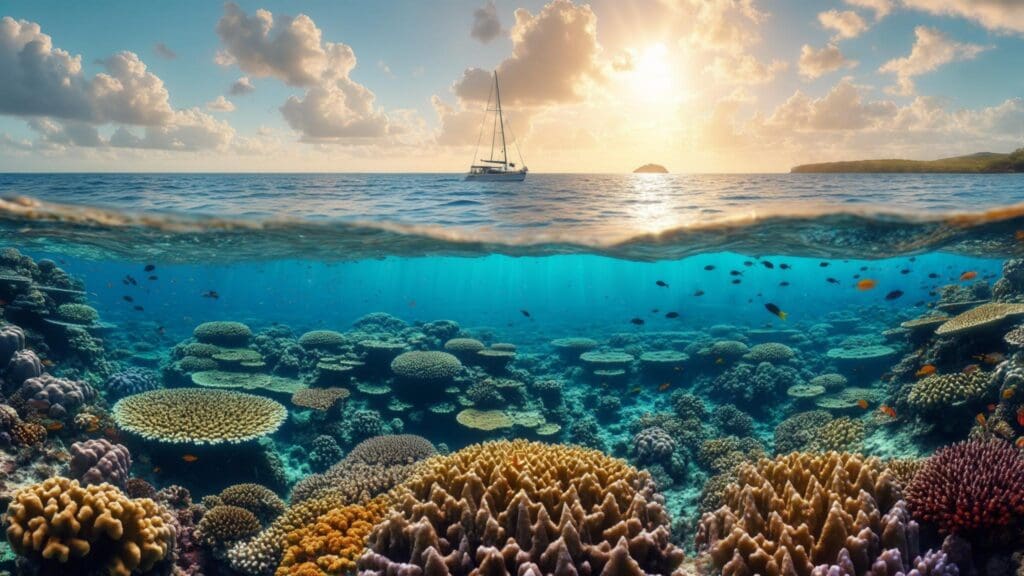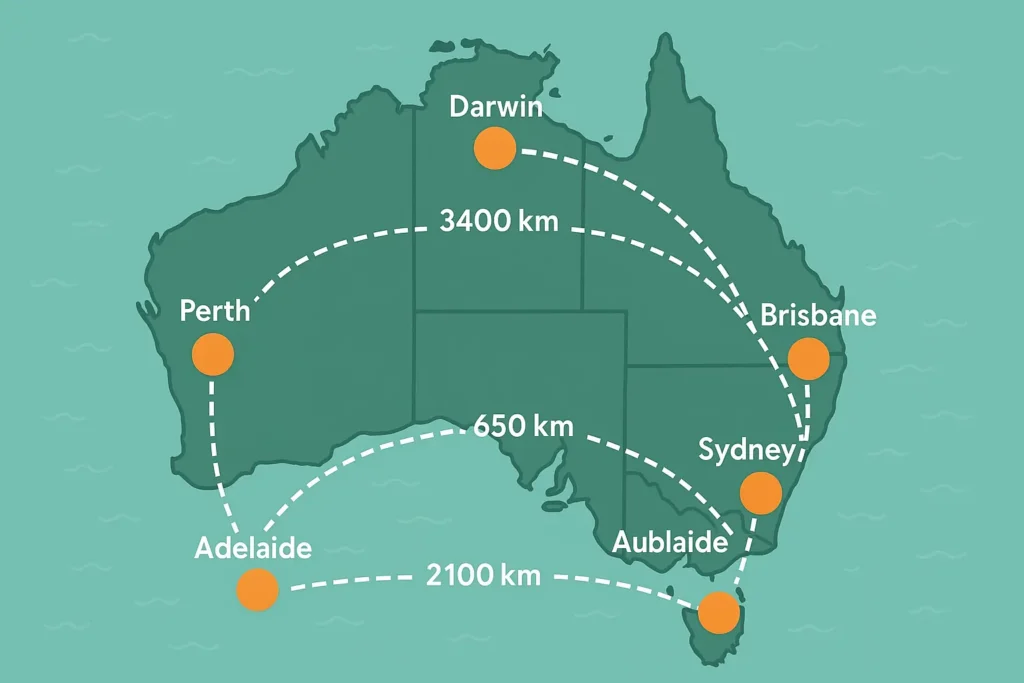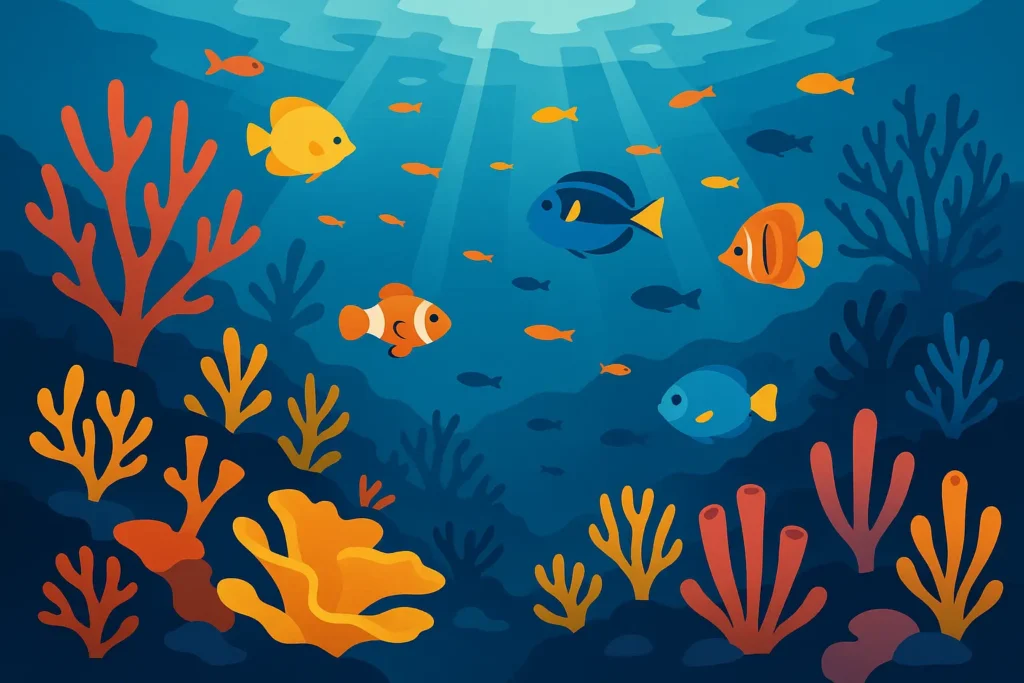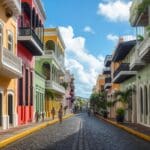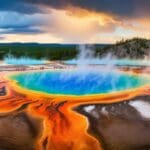Three years ago, I was totally overwhelmed trying to plan my Australia trip. I’d spend hours researching online and still feel like I knew nothing! Recent data from the Australian Bureau of Statistics shows that 743,210 international visitors arrived in Australia in July 2025 alone – a 12.8% increase from the previous year. The country’s massive size (roughly equivalent to the continental United States) meant I could spend months researching and still feel unprepared.
That overwhelming feeling of “where do I even start?” when planning an australia itinerary is exactly why I’ve compiled these 25 proven itineraries. Each one addresses different travel styles, budgets, and time constraints, giving you a clear roadmap instead of endless possibilities.
Use our Vacation Planner to build your ideal Australia trip
Quick Resources
TL;DR
- Australia offers 25+ distinct itinerary types ranging from 7-21 days, with budgets from $2,500-$15,000+ per person
- East Coast adventures (Sydney-Melbourne-Cairns) work year-round but are optimal March-May and September-November
- Outback expeditions require April-September timing due to extreme summer temperatures exceeding 45°C
- Great Barrier Reef experiences are best May-October for diving conditions and stinger-free swimming
- Domestic flights are essential for covering Australia’s vast distances – driving Sydney to Perth takes 40+ hours
- Remote areas require 4WD vehicles, satellite communication, and specialized safety equipment
- Fitness levels vary dramatically from relaxed wine tours to challenging multi-day hiking expeditions
- Group dynamics significantly impact itinerary success – plan for varying interests and compromise activities
Essential Planning Considerations for Your Australia Adventure
Planning an australia travel itinerary isn’t just about picking destinations from a map. The country’s unique geography, climate extremes, and vast distances create planning challenges you won’t encounter elsewhere.
Here’s what nobody tells you: Australia is HUGE. Like, stupidly huge. You can’t just hop in a car and see everything. You’ll either go broke buying gas or die of boredom in the middle of nowhere.
Start your customized journey with the Vacation Planner
Seasonal Timing & Weather Patterns
Australia’s seasons run opposite to the Northern Hemisphere, which totally messed with my head at first. Summer spans December through February, while winter covers June to August. But here’s the kicker – the country’s massive size means you’ll encounter everything from tropical monsoons in the north to temperate conditions in the south.
Northern regions don’t even follow normal seasons. They have wet and dry seasons instead. The wet season (November-April) brings intense rainfall, flooding, and dangerous marine stingers that make swimming impossible in many coastal areas. Trust me, you don’t want to mess with box jellyfish – their sting feels like being whipped with fire.
| Region | Best Months | Weather Conditions | Key Considerations |
|---|---|---|---|
| East Coast | Mar-May, Sep-Nov | Mild temperatures, low rainfall | Avoid summer crowds and heat |
| Outback/Red Center | Apr-Sep | Cool mornings, warm days | Summer temperatures deadly |
| Tropical North | May-Oct | Dry season, calm seas | Wet season brings stingers |
| Southern Australia | Nov-Apr | Warm, hiking season | Year-round access available |
| Western Australia | Apr-Oct | Mild temperatures | Whale shark season overlap |
Here’s the deal with timing: If you go to the Outback in summer, you might literally die from heat stroke. I’m not being dramatic – it regularly hits 113°F (45°C). Southern regions are more forgiving, but even Tasmania has its hiking season from November through April.
Budget & Duration Realities
Okay, let’s talk about the elephant in the room – Australia will drain your bank account faster than a teenager with your credit card. My friend Sarah thought she’d eat cheap for two weeks. Her first meal in Sydney cost $25 for a basic burger and fries.
Accommodation costs range from $100-400+ per night for decent options, while domestic flights between major cities cost $200-800 each. Car rentals run $40-80 daily, and signature experiences cost $50-300 per activity.
Consider Sarah and Mike’s 14-day East Coast adventure: They spent $6,200 per person including flights from Sydney to Melbourne ($180), accommodation averaging $150/night, rental car for coastal drives ($65/day), Great Barrier Reef day trip ($220 each), and restaurant meals averaging $45 per person daily. Their mid-range approach provided comfortable experiences without luxury premiums.
The good news? Longer itineraries actually offer better value because you’re not constantly paying for flights between cities. A 14-day trip lets you actually experience 4-5 destinations instead of becoming an expensive airport-hopping exercise.
See how your costs stack up—try the Vacation Planner’s budget tool
Geographic Scale & Transportation Challenges
I once booked what I thought would be a “quick” drive from Sydney to Melbourne, thinking it was like driving between neighboring states back home. Eight hours later, I finally understood why everyone kept asking if I was sure about driving everywhere.
Australia’s continental size creates transportation decisions that dramatically impact your australia itinerary. The distance from Sydney to Perth equals driving from New York to Denver – a 40+ hour journey that most sane people complete by air.
Flying between major cities becomes necessary for multi-region tours, while regional exploration works best with rental cars. However, remote areas require 4WD vehicles and specialized equipment that significantly increases costs and complexity.
Build your full route and transport plan with the Vacation Planner
Classic East Coast Adventures
The east coast of australia delivers Australia’s greatest hits in a manageable travel corridor. From Melbourne’s coffee culture (seriously, it’s addictive) to Cairns’ reef access, this region offers maximum diversity with minimal logistical complexity.
1. The Ultimate East Coast Australia Travel Itinerary (14 Days)
Route: Melbourne → Sydney → Byron Bay → Brisbane → Cairns
This trip hits all the Instagram-famous spots without making you feel like you’re running a marathon with a backpack. You’ll experience urban sophistication, beach culture, and natural wonders without the exhausting rush of shorter itineraries. This australia itinerary 14 days approach provides the perfect balance of exploration and relaxation.
Days 1-3: Melbourne – Start with Australia’s cultural capital, where the coffee is so good it’s basically a religion. Explore famous laneways filled with street art, pretend you’re artsy in the Royal Botanic Gardens, and take a day trip along the Great Ocean Road to see the Twelve Apostles limestone formations.
Days 4-6: Sydney – Australia’s most famous city delivers with Opera House tours, Harbour Bridge climbing experiences (if you’re not afraid of heights), Bondi Beach relaxation, and Blue Mountains day trips featuring scenic railways and bushwalking.
Days 7-9: Byron Bay – This hippie haven offers lighthouse walks with whale watching opportunities, pristine beach relaxation, hinterland tours through subtropical rainforest, and insight into Australia’s counterculture movement. Fair warning: you might never want to leave.
Days 10-11: Brisbane – Queensland’s capital provides South Bank cultural precinct exploration, Story Bridge adventure climbs, and Lone Pine Koala Sanctuary encounters with native wildlife. Pro tip: koalas sleep 20 hours a day, so don’t expect much action.
Days 12-14: Cairns – Your tropical finale includes Great Barrier Reef diving or snorkeling expeditions, Daintree Rainforest exploration (the world’s oldest surviving rainforest), and Kuranda village visits via scenic railway.
Yeah, it’s going to cost you. We’re talking $4,000-7,000 per person including domestic flights – about the same as a decent used car. But trust me, it’s worth every penny.
2. Two Weeks in Australia: Sydney-Centric Explorer
Base: Sydney with strategic day trips and short excursions
This approach is perfect for people who hate packing and unpacking every few days. You’ll keep the same hotel room while accessing diverse experiences through day trips and weekend getaways. Perfect for those planning two weeks in australia who prefer a home base strategy.
Spend seven days exploring Sydney’s neighborhoods, from The Rocks historic area to trendy Surry Hills. Take the scenic train journey to Blue Mountains for bushwalking and scenic lookouts. Weekend trips to Hunter Valley provide world-class wine tasting experiences, while Port Stephens offers dolphin watching and sand dune adventures.
This approach costs $3,500-6,000 per person with lower transportation costs but higher accommodation expenses in Sydney. Worth it if you value stability over constant movement.
3. Eastern Australia Wildlife & Nature Focus
Route: Brisbane → Sunshine Coast → Fraser Island → Townsville → Cairns
This nature-focused journey prioritizes Australia’s unique fauna and pristine environments over urban experiences. You’ll encounter everything from koalas and kangaroos to cassowaries and crocodiles in their natural habitats across eastern australia.
Fraser Island (K’gari) provides the world’s largest sand island experience with dingo encounters, pristine lakes, and shipwreck exploration. Townsville offers Magnetic Island’s wild koala populations, while Cairns provides access to both reef marine life and rainforest creatures.
Perfect for wildlife enthusiasts and nature photographers, this itinerary costs $4,500-7,500 per person including specialized wildlife tours and island accommodations. Just remember – Australian wildlife can kill you in creative ways, so listen to your guides.
4. Backpacker’s East Coast Budget Adventure
Route: Melbourne to Cairns via Greyhound bus with hostel accommodations
This budget-conscious approach uses Australia’s extensive bus network and hostel infrastructure to minimize costs while maximizing social experiences. You’ll travel with like-minded adventurers while accessing the same destinations as luxury travelers.
Jake’s 21-day backpacker journey cost just $2,800 total by using Greyhound bus passes ($450), hostel dorms averaging $25/night, cooking meals in hostel kitchens, and choosing free activities. He met travel companions at each stop and joined group activities that reduced individual costs further.
The social aspect is huge – hostels provide built-in travel companions and local insider knowledge. Perfect for solo travelers and budget-conscious groups, this approach reduces costs to $2,500-4,000 per person while extending travel duration.
5. Luxury East Coast Indulgence
Route: Same as Ultimate East Coast but with premium accommodations and exclusive experiences
This elevated version transforms the classic route into a luxury experience with 5-star hotels, private transfers, and exclusive access to premium experiences. You’ll enjoy the same destinations with enhanced comfort and personalized service.
Stay at Park Hyatt Sydney with Opera House views, experience private Great Barrier Reef charters, and enjoy helicopter transfers between destinations. Premium wine tastings, spa treatments, and fine dining elevate every aspect of the journey.
For travelers seeking maximum comfort and exclusive experiences, this luxury approach costs $8,000-15,000+ per person. Yes, it’s expensive, but you’re basically traveling like a celebrity.
6. Family-Friendly East Coast Journey
Route: Modified classic route with kid-focused activities and shorter travel days
This family-adapted version prioritizes educational experiences, interactive attractions, and manageable travel segments that keep children engaged throughout the journey.
Theme parks on the Gold Coast, interactive aquariums, hands-on museums, and gentle adventure activities replace challenging hikes and late-night entertainment. Accommodation includes family rooms and resort facilities with kids’ clubs and pools.
Designed for families with children aged 5-15, this itinerary costs $5,000-8,000 for a family of four. The key is keeping travel days short and building in pool time – trust me on this.
7. East Coast Food & Wine Trail
Route: Melbourne → Hunter Valley → Brisbane → Cairns with culinary focus
This gastronomic journey explores Australia’s evolving food scene from Melbourne’s laneway cafes to tropical fruit farms in Far North Queensland. You’ll experience cooking classes, wine tastings, and regional specialties that define Australian cuisine.
Melbourne’s coffee culture and restaurant scene provides the foundation, while Hunter Valley offers world-class wine education. Brisbane’s New Farm area showcases modern Australian cuisine, and Cairns introduces tropical ingredients and indigenous food traditions.
Perfect for food enthusiasts and wine lovers, this culinary-focused journey costs $5,500-9,000 per person. Warning: you’ll probably gain weight, but it’s totally worth it.
Outback & Red Center Expeditions
Listen, the Outback isn’t Instagram pretty. It’s hot, dusty, and there’s literally nothing for hundreds of miles. But somehow, it’s the most incredible thing you’ll ever see. These expeditions require serious preparation but reward adventurers with landscapes and experiences impossible to find elsewhere.
8. The Complete Red Center Experience (10 Days)
Route: Alice Springs → Uluru → Kings Canyon → MacDonnell Ranges
This comprehensive Outback journey covers the Red Center’s essential experiences while respecting the challenging environment and cultural significance of the region.
Days 1-2: Alice Springs – Establish your Outback base with Telegraph Station historical tours, Desert Park wildlife encounters, and hot air ballooning over the MacDonnell Ranges at sunrise. Fair warning: Alice Springs is basically in the middle of nowhere, but that’s the point.
Days 3-5: Uluru-Kata Tjuta – Experience Australia’s spiritual heart with sunrise and sunset viewing positions, base walks around Uluru’s circumference, cultural center education about Anangu traditions, and the famous Sounds of Silence dinner under desert stars. Pro tip: Don’t climb Uluru – it’s disrespectful to traditional owners.
Days 6-7: Kings Canyon – Challenge yourself with the rim walk offering spectacular views, discover the Garden of Eden waterhole oasis, and experience luxury camping under some of the world’s clearest night skies. The stars out here will blow your mind.
Days 8-10: MacDonnell Ranges – Explore Ormiston Gorge’s ancient rock formations, walk through Standley Chasm’s narrow walls, and cool off in remote swimming holes that provide relief from desert heat.
| Outback Activity | Fitness Level | Duration | Cost Range | Best Season |
|---|---|---|---|---|
| Uluru Base Walk | Moderate | 3-4 hours | Free | Apr-Sep |
| Kings Canyon Rim Walk | High | 3-4 hours | Free | Apr-Sep |
| Desert Park Tours | Low | 2 hours | $30-45 | Year-round |
| Sounds of Silence Dinner | Low | 3 hours | $220-280 | Apr-Oct |
| Hot Air Ballooning | Low | 4 hours | $450-650 | Apr-Oct |
This challenging but rewarding expedition costs $3,500-6,000 per person. April-September timing isn’t just recommended – it’s essential to avoid dangerous summer temperatures that can literally kill you.
9. Outback Towns & Mining Heritage
Route: Broken Hill → Coober Pedy → Alice Springs
This cultural journey explores Australia’s mining history and the unique communities that developed around resource extraction in harsh environments. Spoiler alert: people got creative about surviving in impossible places.
Broken Hill showcases silver mining heritage with underground tours and historic architecture. Coober Pedy offers the surreal experience of underground hotels, churches, and homes built to escape extreme surface temperatures. Underground opal mining tours and cutting demonstrations provide insight into this uniquely Australian industry.
Perfect for history enthusiasts and those seeking unique accommodation experiences, this itinerary costs $3,000-5,500 per person. You’ll literally sleep underground, which is either cool or claustrophobic depending on your personality.
10. Aboriginal Cultural Immersion
Route: Arnhem Land → Kakadu → Uluru with indigenous guides
This profound cultural journey provides authentic indigenous perspectives on country, culture, and traditional knowledge systems that span 65,000+ years of continuous connection to land.
Arnhem Land requires special permits and indigenous guide accompaniment, providing access to rock art sites and cultural practices unavailable elsewhere. Kakadu National Park offers extensive rock art galleries and cultural interpretation, while Uluru provides deep spiritual significance education from traditional owners.
This culturally sensitive journey requires advance booking and costs $6,000-10,000 per person due to specialized access and indigenous guide requirements. You’ll gain profound understanding of the world’s oldest continuous culture – it’s life-changing stuff.
11. Outback Photography Safari
Route: Specialized locations timed for optimal lighting conditions
This technical journey focuses on capturing Australia’s dramatic landscapes during golden hour conditions, with professional photography instruction and access to exclusive locations.
Specialized tours target sunrise and sunset positions at iconic locations, wildlife photography opportunities, and landscape composition instruction. Professional guides provide technical expertise while ensuring safety in remote locations.
Designed for serious photographers, this specialized itinerary costs $4,500-8,000 per person and includes professional instruction, specialized equipment access, and exclusive location permits.
12. Extreme Outback Challenge
Route: Simpson Desert crossing or Canning Stock Route
This expedition-level journey is designed for experienced 4WD adventurers seeking Australia’s most challenging overland routes through some of the continent’s most remote regions.
Simpson Desert crossing involves 1,100+ sand dunes and complete self-sufficiency for 7-10 days. The Canning Stock Route covers 1,850km of remote track with historical significance and extreme isolation requiring satellite communication and emergency preparation.
Only for experienced 4WD adventurers with desert travel experience, these expeditions cost $8,000-15,000 per person. Seriously, don’t attempt this unless you know what you’re doing – people die out there.
Tropical North & Reef Adventures
Swimming with whale sharks sounds terrifying until you realize they’re basically gentle giants who eat plankton. Think of them as ocean puppies the size of school buses. The tropical north delivers Australia’s most spectacular marine experiences alongside the world’s oldest surviving rainforest.
13. Great Barrier Reef Master Explorer (12 Days)
Route: Cairns → Port Douglas → Townsville → Whitsundays → Brisbane
This comprehensive reef exploration covers multiple reef sections and access points, providing diverse marine experiences from day trips to liveaboard diving adventures.
Days 1-3: Cairns – Begin with outer reef day trips to pristine coral gardens, night diving experiences to observe nocturnal marine life, and Kuranda scenic railway journey through ancient rainforest canopy.
Days 4-5: Port Douglas – Experience Low Isles sailing with snorkeling in protected lagoons, Daintree Rainforest discovery tours, and luxury resort relaxation between water activities.
Days 6-7: Townsville – Explore Magnetic Island’s fringing reefs, visit Reef HQ Aquarium for marine education, and discover WWII history at local museums and wreck sites.
Days 8-10: Whitsundays – Join sailing charters through 74 tropical islands, experience Whitehaven Beach’s pure silica sand, and hike to Hill Inlet lookout for panoramic views of swirling sand patterns.
Days 11-12: Brisbane – Decompress with urban relaxation, shopping at Queen Street Mall, and departure preparation after intensive water activities.
Marine biologist Emma’s reef exploration included 3-day liveaboard diving at Cod Hole ($850), swimming with minke whales during migration season (June-July), and completing her Advanced Open Water certification ($420) while diving at world-class sites. Her total reef experience cost $2,200 but provided diving credentials and marine encounters impossible elsewhere.
This water-focused adventure costs $5,000-9,000 per person including liveaboard diving experiences, with May-October timing essential for optimal diving conditions and when you won’t get stung by jellyfish that could kill you.
14. Tropical Islands Hopping
Route: Hamilton Island → Fitzroy Island → Green Island
This resort-based approach provides luxury island accommodations with easy reef access and minimal travel stress between destinations.
Hamilton Island offers resort facilities with direct reef access, championship golf courses, and marina dining. Fitzroy Island provides rainforest walks combined with fringing reef snorkeling, while Green Island delivers easy reef access with glass-bottom boat options for non-swimmers.
Perfect for travelers seeking comfort with reef access, this approach costs $4,500-8,000 per person with resort accommodations and includes options for people who can’t swim but still want to see the reef.
15. Diving Certification Adventure
Route: Cairns-based with progressive certification levels
This educational journey combines diving instruction with world-class reef exploration, allowing beginners to earn certifications while experiencing premier dive sites.
Progress from Open Water to Advanced Open Water certification while diving at sites including Cod Hole, Ribbon Reefs, and Osprey Reef. Professional instruction ensures safety while maximizing learning opportunities at world-renowned locations.
Ideal for diving beginners seeking certification at world-class sites, this approach costs $3,500-6,000 per person including certification fees and provides internationally recognized diving credentials that’ll make your friends jealous.
16. Rainforest to Reef Journey
Route: Daintree → Cape Tribulation → Great Barrier Reef
This unique ecosystem exploration covers the rare location where ancient rainforest meets coral reef, creating biodiversity found nowhere else on Earth.
Daintree Rainforest provides 180-million-year-old ecosystem exploration with guided walks revealing ancient plant species and unique wildlife. Cape Tribulation offers the exact meeting point of rainforest and reef, while reef excursions showcase marine biodiversity.
Perfect for nature enthusiasts and eco-tourists, this specialized journey costs $4,000-7,000 per person and provides unique access to dual World Heritage environments.
17. Tropical North Cultural Discovery
Route: Cairns region with indigenous cultural focus
This cultural journey explores Aboriginal art galleries, cultural centers, and traditional fishing practices within tropical settings, providing authentic indigenous perspectives on country and culture.
Visit Tjapukai Aboriginal Cultural Park for traditional performances, explore local art galleries featuring contemporary indigenous artists, and participate in traditional fishing and hunting demonstrations with local indigenous guides.
This culturally enriching experience costs $3,500-6,000 per person and provides authentic indigenous cultural education within tropical environments, requiring respectful participation and cultural sensitivity.
Southern Highlights & Islands
Southern Australia delivers dramatic contrasts from rugged wilderness to sophisticated wine regions, with island destinations offering unique wildlife encounters and pristine environments.
18. Tasmania’s Wild Wilderness (14 Days)
Route: Hobart → Cradle Mountain → Bay of Fires → Freycinet → MONA
This comprehensive Tasmanian adventure covers the island’s diverse landscapes from urban culture to pristine wilderness areas requiring serious hiking preparation.
Days 1-3: Hobart – Explore MONA (Museum of Old and New Art) with its provocative contemporary collections, browse Salamanca Markets for local crafts and produce, and ascend Mount Wellington for panoramic city views.
Days 4-6: Cradle Mountain-Lake St Clair – Tackle sections of the famous Overland Track through alpine landscapes, complete the Dove Lake circuit walk with mountain reflections, and experience luxury eco-lodge accommodations.
Days 7-8: Bay of Fires – Discover orange lichen-covered granite rocks creating stunning coastal contrasts, walk pristine beaches with minimal human impact, and stay at exclusive eco-lodges with gourmet dining.
Days 9-11: Freycinet Peninsula – Hike to Wineglass Bay lookout for iconic curved beach views, kayak through protected waters with wildlife encounters, and spot Tasmanian devils and wombats during evening wildlife tours.
Days 12-14: Return to Hobart – Take Bruny Island day trips for cheese tastings and lighthouse visits, tour whisky distilleries producing award-winning single malts, and enjoy farewell dinners featuring local produce.
This challenging wilderness adventure requires high fitness levels for serious hiking and costs $4,000-7,000 per person. November-April timing provides optimal hiking weather, though Tassie’s weather can be unpredictable even in summer.
19. Adelaide Hills & Kangaroo Island Escape
Route: Adelaide → Adelaide Hills → Kangaroo Island
This accessible South Australian journey combines wine region exploration with unique wildlife encounters on Australia’s third-largest island.
Adelaide Hills provides cool-climate wine tastings, charming German-heritage towns including Hahndorf, and scenic drives through rolling vineyard landscapes. Kangaroo Island offers guaranteed wildlife encounters including echidnas, kangaroos, and koalas in natural habitats, plus pristine beaches and local honey tastings.
Perfect for wine enthusiasts and wildlife lovers, this relaxed itinerary costs $3,500-6,000 per person and works year-round with comfortable accommodations and moderate activity levels.
20. Great Ocean Road Classic Drive
Route: Melbourne → Twelve Apostles → Port Fairy → Grampians
This iconic coastal drive delivers Australia’s most famous scenic route with inland detours to mountain wilderness areas.
The coastal section features limestone stack formations, historic lighthouses, and seaside towns with local seafood specialties. Inland Grampians provide rock climbing opportunities, Aboriginal rock art sites, and wildflower displays during spring months.
This flexible self-drive adventure costs $3,000-5,500 per person and works year-round, offering everything from luxury accommodations to camping options with moderate activity levels.
21. Southern Wine & Food Circuit
Route: Barossa Valley → Clare Valley → Adelaide Hills → Coonawarra
This gastronomic journey explores Australia’s premium wine regions with world-class cellar door experiences and gourmet dining.
Barossa Valley provides full-bodied red wine education with historic wineries and German heritage cuisine. Clare Valley offers Riesling specialization with boutique producers, while Coonawarra delivers premium Cabernet Sauvignon in a unique terra rossa soil environment.
Ideal for serious wine enthusiasts, this luxury-focused journey costs $4,500-8,000 per person and includes premium wine tastings, cooking classes, and fine dining experiences at award-winning restaurants.
Western Australia Discoveries
Western Australia’s vast distances and remote locations create logistical challenges, but reward adventurous travelers with pristine environments and unique wildlife encounters found nowhere else.
22. Perth to Broome Coastal Adventure (16 Days)
Route: Perth → Margaret River → Monkey Mia → Exmouth → Broome
This epic coastal journey covers Western Australia’s diverse environments from wine regions to remote wilderness areas requiring 4WD capability and careful planning.
Days 1-3: Perth – Explore Kings Park botanical gardens with city skyline views, take Rottnest Island day trips for quokka encounters (they’re basically smiling marsupials), and browse Fremantle markets for local crafts and seafood.
Days 4-6: Margaret River – Experience world-class wine tastings at boutique vineyards, explore limestone caves with underground formations, and surf or relax at pristine beaches with consistent swells.
Days 7-8: Monkey Mia – Participate in wild dolphin feeding experiences with research center education, visit Shell Beach composed entirely of cockle shells, and explore stromatolites representing Earth’s earliest life forms.
Days 9-12: Exmouth/Ningaloo – Swim with whale sharks (world’s largest fish) during season, snorkel pristine coral reefs directly accessible from beaches, and explore Cape Range National Park with red rock gorges.
Days 13-16: Broome – Watch spectacular sunsets from Cable Beach with camel rides, tour pearl farms explaining cultured pearl production, and discover dinosaur footprints preserved in ancient rock formations.
This remote adventure requires 4WD rental and costs $6,000-10,000 per person due to distances and specialized experiences. April-October timing is essential for comfortable temperatures and whale shark season.
23. Kimberley Wilderness Expedition
Route: Broome → Gibb River Road → Mitchell Falls → Darwin
This extreme adventure covers one of Australia’s last wilderness frontiers, requiring serious 4WD experience and complete self-sufficiency for extended periods.
The Gibb River Road provides 660km of challenging 4WD track through remote cattle stations and Aboriginal communities. Mitchell Falls requires helicopter access or challenging multi-day hiking, while the entire region demands satellite communication and emergency preparation.
Only for experienced 4WD adventurers, this expedition costs $10,000-18,000 per person and requires extensive preparation, specialized equipment, and emergency communication systems for safety in extreme remote conditions.
24. Perth City & Surrounds Relaxed Tour
Route: Perth base with day trips to Swan Valley, Rottnest Island, Pinnacles, Wave Rock
This accessible Western Australian experience uses Perth as a comfortable base while exploring the region’s highlights through manageable day trips.
Swan Valley provides wine tastings and gourmet food experiences just 30 minutes from Perth. Rottnest Island offers quokka encounters and pristine beaches via ferry. The Pinnacles create otherworldly limestone formations, while Wave Rock showcases unique geological formations.
Perfect for travelers seeking Western Australian highlights without remote travel challenges, this approach costs $3,500-6,000 per person and works year-round with comfortable Perth accommodations.
25. Wildflower & Whale Season Special
Route: Perth region timed for September-November seasonal spectaculars
This seasonal journey captures Western Australia’s famous wildflower blooms and southern right whale migration, creating spectacular natural displays available only during specific months.
Wildflower season transforms normally arid landscapes into colorful carpets extending to horizons, while whale watching from coastal vantage points provides intimate encounters with migrating southern right whales and their calves.
This seasonal spectacular requires precise timing for September-November and costs $4,000-7,000 per person, providing unique natural phenomena unavailable at other times or locations.
Timing Your Trip: When to Visit Each Region
Australia’s diverse climate zones and seasonal variations require strategic timing for optimal experiences. Getting this wrong can literally ruin your trip.
East Coast Regions: March-May and September-November provide ideal conditions across the entire coast. Summer (December-February) brings intense heat and crowds that’ll make you question your life choices, while winter (June-August) offers comfortable temperatures but potential rain in tropical areas.
Outback & Red Center: April-September represents the only safe period for Outback travel. Summer temperatures regularly exceed 45°C, creating dangerous conditions even for experienced travelers. I’m not kidding – people die from heat stroke out there.
Tropical North: May-October delivers optimal diving conditions with calm seas and when you won’t get stung by jellyfish that could kill you. The wet season (November-April) brings dangerous marine stingers, intense rainfall, and potential cyclones that can disrupt travel plans.
Southern Regions: November-April provides Tasmania’s hiking season, though mainland southern areas remain accessible year-round. Winter offers unique experiences including snow in alpine areas and fewer crowds at popular attractions.
Western Australia: April-October avoids extreme summer heat while capturing whale shark season and wildflower blooms. Summer temperatures can exceed 40°C regularly, making outdoor activities dangerous during midday hours.
Budget Breakdown: What You’ll Actually Spend
Look, Australia is expensive. Like, painfully expensive. That $4 coffee you complain about at home? Try $6-8 in Australia. And don’t get me started on accommodation…
| Budget Category | Budget Range | Mid-Range | Luxury | Remote/Outback |
|---|---|---|---|---|
| Accommodation | $25-50/night | $100-200/night | $300-800/night | $150-400/night |
| Transportation | Bus passes $300-500 | Domestic flights $200-800 | Private transfers $500-1500 | 4WD rental $80-150/day |
| Activities | Free-$50 | $50-300 | $300-1000+ | $100-500 |
| Food | $15-30/day | $40-80/day | $100-200/day | $30-60/day |
| Total per person | $2,500-4,000 | $4,000-7,000 | $7,000-15,000+ | Add 30-50% |
Budget Range ($2,500-4,000 per person): Backpacker hostels, bus transportation, self-catering, free activities, and basic tours. This approach extends travel duration while minimizing daily costs through shared accommodations and public transportation.
Mid-Range ($4,000-7,000 per person): Comfortable hotels, domestic flights, rental cars, restaurant meals, and standard tours. This range provides good comfort levels while accessing most experiences without luxury premiums.
Luxury ($7,000-15,000+ per person): 5-star accommodations, private transfers, exclusive experiences, fine dining, and premium tours. This level provides maximum comfort and access to experiences unavailable to regular tourists.
Remote/Outback Premium: Add 30-50% to base budgets for remote area travel due to specialized equipment, 4WD rentals, satellite communication, and limited accommodation options requiring advance booking.
Major cost categories include accommodation typically representing 40-50% of budgets, transportation 25-30%, activities and tours 15-20%, and food 10-15%. Remote areas shift these percentages toward transportation and specialized equipment.
Transportation Guide: Getting Around Australia
Everyone thinks they can drive everywhere in Australia. Trust me, driving from Sydney to Perth is like driving from New York to Los Angeles – except more boring and with fewer gas stations.
Domestic Flights: Essential for multi-region itineraries covering distances such as Sydney to Perth (4,000km). Book domestic flights 6-8 weeks in advance for best prices, with budget carriers offering significant savings on popular routes.
Rental Cars: Necessary for regional exploration and flexibility, but consider fuel costs for long distances. Standard vehicles work for sealed roads, while 4WD becomes essential for remote areas and unsealed tracks.
4WD Requirements: Outback travel, remote beaches, and many national parks require 4WD capability. Rental companies provide specialized equipment including satellite phones, extra fuel capacity, and recovery gear for remote area travel.
Public Transportation: Limited outside major cities, though bus networks connect major destinations along the east coast. Train services exist but often take significantly longer than flying or driving.
Campervan Options: Popular for extended travel, providing accommodation and transportation in one package. However, fuel costs and campground fees can exceed hotel and flight combinations for shorter trips.
Fitness & Activity Level Requirements
Australia’s diverse activities require honest assessment of your physical capabilities and preparation time.
Low Activity Level: City tours, wine regions, resort-based islands, and cultural experiences require minimal fitness. These itineraries work well for travelers with mobility limitations or those preferring relaxed exploration.
Moderate Activity Level: Mixed activities including some hiking, water sports, and walking tours require basic fitness. Most travelers can handle these activities with minimal preparation, though comfortable walking shoes become essential.
High Activity Level: Serious hiking, remote camping, challenging water activities, and multi-day expeditions require good fitness and preparation. These experiences often provide the most rewarding memories but demand physical and mental preparation.
Specific Preparations: Outback travel requires heat tolerance and emergency preparedness. Reef activities need swimming confidence and comfort with water-based activities. Mountain hiking demands cardiovascular fitness and proper equipment.
Group Travel Considerations
Traveling with friends in Australia is like herding cats. Someone always wants to party in Sydney while someone else wants to meditate with kangaroos. Good luck with that.
Interest Variations: Some travelers prefer urban experiences while others seek wilderness adventures. Plan itineraries with diverse activities and consider split days where groups can pursue different interests before reuniting.
Fitness Disparities: Groups often include varying fitness levels requiring activity modifications. Choose itineraries with optional challenging activities and alternative easier options for the same destinations.
Budget Differences: Accommodation and activity preferences vary significantly within groups. Consider mid-range options that satisfy most preferences, or plan split accommodations where budget-conscious travelers choose hostels while others select hotels.
Decision Making: Establish group decision-making processes before departure to avoid conflicts during travel. Designate a trip leader or use democratic voting for major decisions while maintaining flexibility for individual preferences.
Visa Requirements & Health Safety Tips
Visa Requirements: Most visitors need an ETA (Electronic Travel Authority) or eVisitor visa, both free and processed online within minutes. US citizens can stay up to 90 days, while many other nationalities receive 90-180 day permissions. Apply at least two weeks before travel to avoid last-minute complications.
Health Considerations: Australia has no required vaccinations for most travelers, but travel insurance becomes essential due to high medical costs. Remote areas require additional preparation including satellite communication devices and emergency beacons for safety.
Unique Dangers: Australia has things that can kill you in ways you never imagined. Box jellyfish? Their sting feels like being whipped with fire. Blue-ringed octopus? Cute but deadly – like a toxic ex. Extreme UV exposure requires constant sun protection, and remote areas present dehydration risks requiring proper preparation.
Cultural Etiquette: Australians value directness and informal communication styles. Environmental respect is crucial, especially around Aboriginal sacred sites where photography may be prohibited. Tipping isn’t expected but is appreciated for exceptional service.
How Professional Planning Support Can Transform Your Trip
Planning a complex Australian adventure shares surprising similarities with organizing major life events – both involve coordinating multiple people with different preferences, managing detailed logistics across various locations, and ensuring everything runs smoothly when there’s no room for error.
Let the AI Wedding Planner simplify your planning from start to finish
Consider the parallels: managing different personalities in a travel group mirrors coordinating people with varying interests and budgets. The same organizational skills that help navigate complex event planning can tackle the stress of coordinating flights, accommodations, and activities across multiple time zones and climate regions.
The 24/7 support system and unbiased perspective that makes professional event coordination so valuable during major celebrations becomes equally crucial when navigating international travel complexities.
Access free, round-the-clock help via our Free 24/7 Wedding Hotline
After all, whether it’s walking down the aisle or exploring Uluru at sunrise, everyone deserves support from someone who’s actually invested in making your adventure unforgettable. Professional coordination ensures your once-in-a-lifetime Australian experience goes perfectly, just as any other major milestone deserves expert attention to detail.
Ready to start planning your epic Australian adventure? Contact Bridesmaid for Hire to discuss how professional planning support can transform your travel dreams into seamlessly executed reality.
Planning a travel + wedding combo? Use our Elopement Planner to coordinate both seamlessly
Final Thoughts
Look, planning an Australia trip is overwhelming. I get it. But here’s the thing – once you’re there watching the sunrise over Uluru or floating above the Great Barrier Reef, you’ll understand why people become obsessed with this place. Just don’t blame me when you start planning your second trip before the first one’s over.
Your Australian adventure awaits, but success depends on choosing the right australia itinerary for your specific circumstances rather than trying to see everything in one trip. The 25 itineraries presented here provide proven frameworks that account for Australia’s unique challenges while maximizing your experience within realistic time and budget constraints.
Remember that Australia rewards preparation and punishes assumptions. The continent’s size, climate extremes, and remote locations create planning requirements unlike other destinations, but proper preparation ensures you’ll experience landscapes and wildlife encounters that will reshape your understanding of what travel can provide.
Whether you choose the classic East Coast adventure, challenge yourself with Outback expeditions, or focus on specific interests such as diving or wine tasting, Australia delivers experiences that justify the planning effort and financial investment. The key lies in honest assessment of your capabilities, interests, and resources, then selecting itineraries that match your reality rather than your fantasies.
Start planning now, because Australia isn’t just another destination – it’s a continent-sized adventure that requires the respect, preparation, and excitement it deserves.
Explore the full suite of planning tools via All Wedding Tools
1-800-BRIDESMAID
The Newlywed
Card Game
something extra to love
Read the weekly newsletter from Bridesmaid for Hire, 1-800-Bridesmaid, to hear about real stories, from strangers, who need advice on love, life, friendship, and so much more.
Looking for the perfect wedding gift for someone you adore? Grab The Newlywed Card Game. It's a fun and interactive game they can play on their honeymoon or future date nights.
